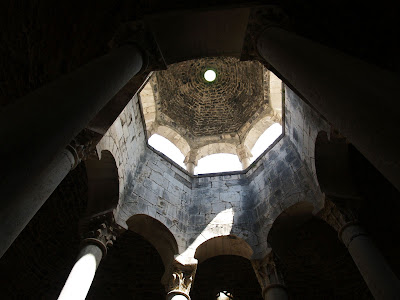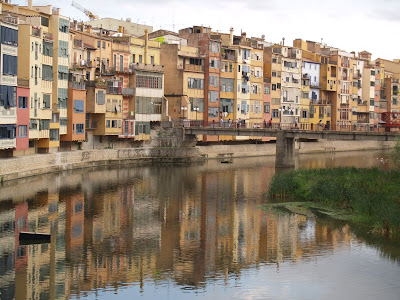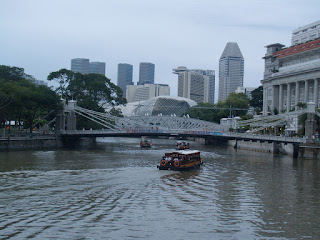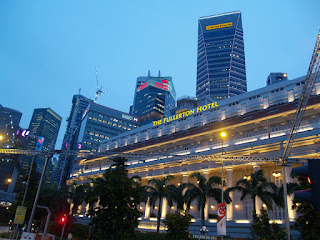No excuses, it is inexcusable not to know some treasures to be found a few steps from home. We are attracted to the distant and exotic and good intentions to learn about our natural and cultural heritage often tend to remain as just that, intentions.
I intend to do homework and spend some weekends to visit places that build up in my long list and one of these places was undoubtedly Girona.
Although we have been visiting many places of the province for many years since I visited the city. In fact, I think since we went on tour with the school had not returned to Girona and since then it has rained a lot. A fuzzy image and the steps of the cathedral with its imposing facade to the fund was how little I remembered.
The biggest change that the city has undergone in recent years is usual comment I wanted to make a visit to the new Girona so often praised.
Taking a little break left us last August, we decided to get going and just over ten in the morning on a relatively cool, sunny Sunday and we were leaving the tourist with a map in hand.
Most attractions are in the old town and concentrated in a small area, ideal for travel on foot.
Instead of crossing the river Onyar the Pont de Sant Feliu , walked to the next bridge called Pont d'en Gómez . The sight of colorful facades houses reflected in the river is one of the most picturesque and most photographed while Girona and inspiration of many artists.
continue to find the church of Sant Feliu . Built outside the city walls, seems to have been built on an ancient Christian church built in honor of the holy martyr who gives the name. In times of Moorish occupation, when the cathedral was converted into a mosque, the church of Sant Feliu did turn, the functions of a cathedral. After extensive restoration and cleaning has taken place in these recent years, the temple looks with all its splendor and simplicity of the Romanesque apses in contrast to the brightness of the large Gothic windows. highlights the Gothic tomb of Sant Narcis , patron of the city and related to one of the many legends told in Girona: According to medieval chronicles, in 1285 when Girona was besieged by French troops, a group of Soldiers moved into the interior of the church. The body of the martyred bishop began to leave some flies that caused high mortality among the French troops and their horses, which led to the withdrawal of troops. Despite the repeated invocations of Sant Narcis and flies in subsequent conflicts, the result was not always so successful.
In a corner of the small square of Sant Feliu , is the column with the stone lion , origin of the popular "If you go to Girona you have to kiss the ass of the lioness , a way of expressing the desire to return to the city. In order to do this without having to play the type has been installed iron ladder, and curious, and last winter because of the alarm caused by the epidemic of influenza A, were temporarily removed prevent contagion. As my intention is to return to Girona, I do comedy and kiss the backside of the lioness but I fear that Josep Maria is not with me why does not fulfill the ritual.
Our next goal is the Romanesque monastery of Sant Pere de Galligants , a former Benedictine abbey and head office of Archaeological Museum since 1857. The whole exterior is magnificent but we are interested in visiting the interior, not museum pieces it contains, which are numerous, but to admire the cloister, one of the most beautiful examples from the Catalan Romanesque cloisters.
different plant and animal motifs decorate the rich capitals, with dancing, double-tailed mermaids, musicians and other human figures and biblical scenes.
Throughout the various rooms of the museum contains a full overview of the history of the city and province, from the Paleolithic and Neolithic, through the Iberian and Roman settlement.
We followed and reached the Arab Baths that Arabs only have the name because its construction is quite later. The building is Romanesque and was built in 1194 imitating the structure of the Muslim baths, then fashionable. You can see the Apodyterium or dressing, the Frigidarium or cold room, the Tepidarium or warm room, the caldarium or hot room and the remains of the furnace. The preserved frigidarium a central octagonal pool over which a dome .
Our tour continues to the Cathedral (free tour on Sunday) led by its magnificent staircase. Dedicated to St. Mary, is at the highest point of the city. His 22.98-meter-wide ship, put it in second place after St. Peter's Cathedral, with 25 meters. Although its construction began in the S. XI only retain faculty and the tower in Romanesque style, while the nave is Gothic and the Baroque facade (1730).
Inside, I recommend visiting the Museum Chapter which preserves the Creation Tapestry (s. XI), an extraordinary Romanesque Room in fairly good condition. Nor do we overlook the magnificent Romanesque cloister, of trapezoidal and limited by the wall above. Is considerably larger that of Sant Pere de Galligants but I think it does not have the charm of it.
Leaving the cathedral, we enter the Jewish quarter down the street Força, the main artery. The Jewish Quarter or Call of Girona is one of the most representative and best preserved in Europe. Thanks to its streets and symbols we know about the history of Judaism in Spain and specifically in Girona, where he lived until the late fifteenth century a thriving community. The current study center Bonastruc Ça Porta, stands in the same area likely was the synagogue. The museum, highly recommended to get into the life and customs of that community, and we found it to be closed because the hours are Sunday mornings only (from 10 to 14). Next time. eat in one of the many restaurants in the Jewish quarter and continue walking down the labyrinth of alleys, getting carried away by the time machine.
In the Jewish Quarter and four steps of the cathedral is the Hostal Bellmirall in the street bearing the same name. This charming and cozy hotel with a rock flavor and taste, is owned by Cristina, who had the pleasure of meeting in Fez, and with whom we share pleasant moments. We take for a visit and chat with her a long time. Though we were very comfortable in your company, we said goodbye to her to continue our route.
From Cathedral we headed for the French Gardens where there is a point of access to wall. From here we have a beautiful view of the back of the cathedral and we can see the famous witch, star of another legend: While the people attending the many processions which took place in the city, a nasty witch was engaged in throwing stones. Just the day of Corpus Christi when he was about to throw a rock, a voice that was heard throughout the city cried out: "If Peter tires, i will pull pedres pedra et will become." And so, therefore today can still see the petrified for ever and ever, turned into a gargoyle.
walked along the wall and up to one of the towers to see one of the best views of the city. At our feet we have the Convent of Sant Domènech , where it is now the headquarters of the university. We do all the way to the Plaza General Mendoza. We walked down the Rambla de la Llibertat where they begin to fill the terraces of bars and ice cream.
Before leaving, we take a last walk along the river and admire again the image of the houses reflected in the Onyar, now with a very special light.



























































































